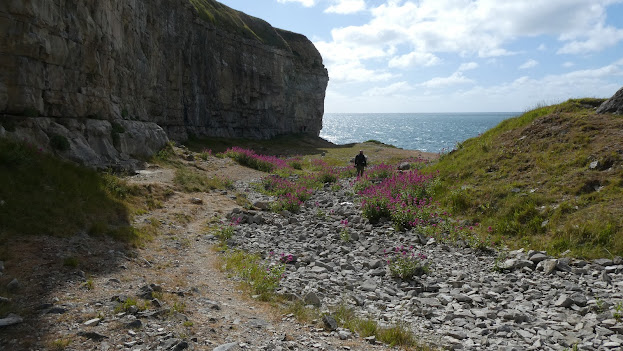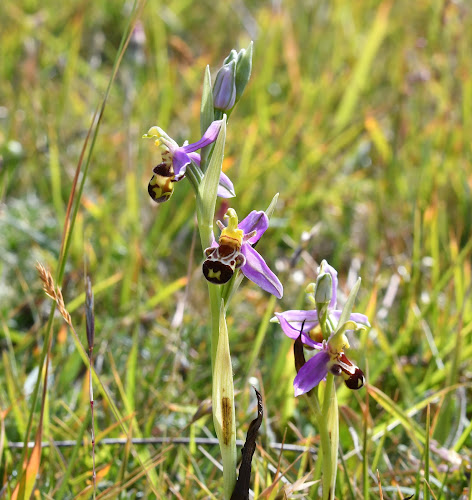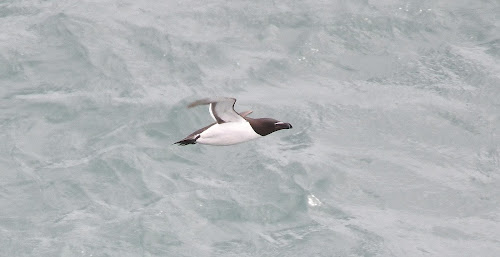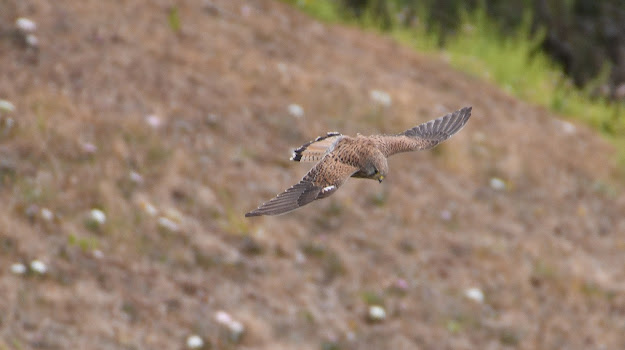It's been about four years since I last visited Durlston on the Isle of Purbeck.
A real gem of a place on the Dorset coast and well worth seeing in June when the whole place is blooming.
I met my friend Chris just off the M27 at silly o'clock to head in convoy to our destination and begin our coastal path walk.
The forecast was bright but very blowy, not necessarily the best conditions to walk a cliff path.
Linnet
The whole place has everything. Seabirds, farmland birds, butterflies, wildflowers and stunning clifftop views.
Plenty of Linnet were around as we headed west and many Corvids too, especially Jackdaws with their smart slate grey hoods.
Lots of low growing scrub smatter the steep hillsides from the path and in almost every one it seemed there were birds singing from them.
Territories of Common Whitethroat - pictured below - Stonechat, Dunnock, Robin, Blackbird and the aforementioned Linnet adorned the area.
Even Roe Deer put in an appearance
Corvids thrive here due to the grazing of the sheep and the insects they attract plus the carrion that naturally occurs
Ravens are top of the chain in that department and nest on the cliffs.
Corvids get a bad rap due to their habits. Most notably, Magpies. The flak they get always troubles me, so consider this. They are doing well and expanding in numbers due to many factors... Road kill because of more roads and more cars. In this regard they are great for clearing up the scraps and preventing disease. Secondly, the numbers of game released into the countryside is in excess of 40 million birds every year, ie pheasant and partridge for shooting estates. Many don't get shot and end up either dead on our roads, or scavenged in the countryside by foxes, corvids and raptors.
So when people see their songbird young predated by the Magpies in their gardens, the birds get a bad name and are hated in return and blamed. They are trying to survive and feed their own young but with an imbalance in numbers, naturally there will be a negative impact, but that isn't all that has an impact on songbird numbers. Habitat loss, decline in food source, less nesting availability, climate change - which affects the first three, so there are several mitigating circumstances. Think about that before you lay the blame at the corvids door, Human behaviour has much more to answer for, so effectively the problem lies at our door. Corvids are also known for their high intellect, so they are doing what comes naturally and are fascinating creatures to study.
I'll get off my soapbox now and back to the story, just needed to get that off my chest..
Our destination and turning point was a place called Dancing Ledge. The path that leads inland from there brings you out at one of the best pubs I've ever been to - The Square and Compass - when it's open of course..
It has a fossil museum in one room adjacent to the pub itself. Being the Jurassic coast it is a hot spot for fossil finds. Well worth a look if you are ever passing on this stretch of coast.
We descended the precipitous path to the old quarry. It was full of Red Valerian, Vipers Bugloss and Sea Pinks or Thrift. As we were closer to sea level it gave us a better view of our intended quarry. Puffins...
Apart from Lundy, Wales, Scotland or Yorkshire, you won't find many Puffins anywhere else, so to see them on the south coast is exciting. A tiny colony of around 14 breeding pairs, it really is clinging on as a breeding species.
Thrift
Red Valerian
We scoured the area for any sign of them in between the Guillemots and Razorbills.
Shags are common here too. Sleeker, more dapper cousins of the Cormorant
Then, as I was videoing the crashing waves over the ledges, Chris bellowed 'Puffin!!' in my direction. I nearly slipped off the said ledge into the briny in my haste to get over to him.
Apart from a brief glimpse of one off Lundy many moons ago, I clapped my eyes on at least four here, occasionally diving for food with the Guillemots some distance ahead of us.
I even caught one in flight, all too distant but no matter, they were Puffins !!
As if that wasn't enough excitement. Chris spotted a Peregrine Falcon arrive and perch on the cliff face. After a bit of direction, I managed to pinpoint it. Ironically, last time we were here, we had superb views of one on the edge of the cliff. It only took another 4 years to get an experience to match, although they are regular sights around our way. I'll let the shots do the talking...
Stunning views of a top predator. Our climb out of the quarry was no less stunning however. Orchid central on the fields that lead down to the sea. Having said that, they weren't as profuse as the last time we were here but no matter, still exciting. The fields are managed very carefully with the grazing by sheep. Some fields are grazed harder but will come back over time. A bit like crop rotation.
Bee Orchids are easily found with a little perseverance and more so are Pyramidal Orchids. They are clearly quite salt tolerant.
Butterflies aren't partial to windy conditions, so to see the ones we did was a bonus. This female Common Blue was nectaring low on the Trefoil out of the strong westerly.
The views above Standing Ledge are quite stunning so I took a panoramic shot with my phone.
Centuary were at the height of their emergence alongside the orchids.
While around these, Rock Pipits fought and fed.
The clattering call of the Stonechat always gives them away. The male was guarding his newborns and wanted us to pass..
In between the Bee Orchids we managed to find a rare Wasp Orchid.
Some Bee Orchids can confuse with their different markings and shape but still essentially a Bee.
Pyramidal Orchid
We had arrived back at Durlston and it's castle which gives great elevated views onto the large seabird colonies below.
Guillemots
Kittewakes...
and Razorbills zip around the cliffs
There's a non stop avian show
On the surface, rafts of Guillemots and Razorbills congregate before heading out to sea to gather food for themselves and their young.
Watching the Guillemots bathing upside down is very entertaining
Razorbill
Guillemot
Guillemot raft
Then out of the blue, Chris called out another raptor spinning around in the sky. My first Hobby of the year and quite unexpected in this place. Not their usual habitat but nature has a way of surprising us.
Shags appeared every now and then as Chris and I stood taking pot shots with our cameras looking down upon them.
Fulmars are quintessential cliff top seabirds that glide the rocks with starched rigid wings
Their stunted snout bill another giveaway when trying to locate them
Our largest gull - The Great Black Backed - patrolled the cliffs looking to take anything to feed itself and it's young waiting nearby. It will swallow a chick in one go should it need to.
Fulmar
Our day was turning into a raptor fest. To see a Kestrel gliding and hovering from above was almost a unique experience. My last time witnessing this was in Cornwall on the Lizard Peninsular cliffs in 2014.
It seemed as though there was a nest nearby by the defensive attitude of the two adults that kept zipping across our vision defending territory from all sorts of perceived threats.
Such as a Raven..
The male and female seem to switch shift on the cliff edge, although we couldn't see any obvious nest.
Not far below, the Great Black Backed Gull's nest had two chicks and two very vocal parents. Not scared of anything taking their young it seemed ?
Not sure what this Jackdaw had in it's bill, it looked like a tissue ?
The views across to Old Harry Rocks and Swanage was quite impressive
We had lunch back in the car park. Our afternoon exploration was to be through the wildflower meadows on the opposite side of the cliff paths. I had never walked this part before but it was well worth it.
I've been looking to catch up with a Bullfinch for what seemed like years. I've seen plenty, but they never stay long enough for some close up shots. Unlike this glorious male...
Greater Knapweed
Vast swathes of Oxeye or Moon Daisies whiplashed in the brisk winds, so I tried to capture them on the slow motion app on my phone camera.
Deep in the meadow a Common Blue rested from the wild onslaught.
Last on our wonderful walk was this Toadflax.
Although just early afternoon, we had been up since 4am so it felt like the end of the day, it was time to head home and contemplate what we had seen. That and sift through the 1200 shots we had accumulated. That's part of the reason I felt it best to compose a full blog around this extraordinary day. It's been way too long, I must write another soon.
The title of this post is an excerpt from the poem 'Peregrine Falcon' by Gillian Clarke
























































































































